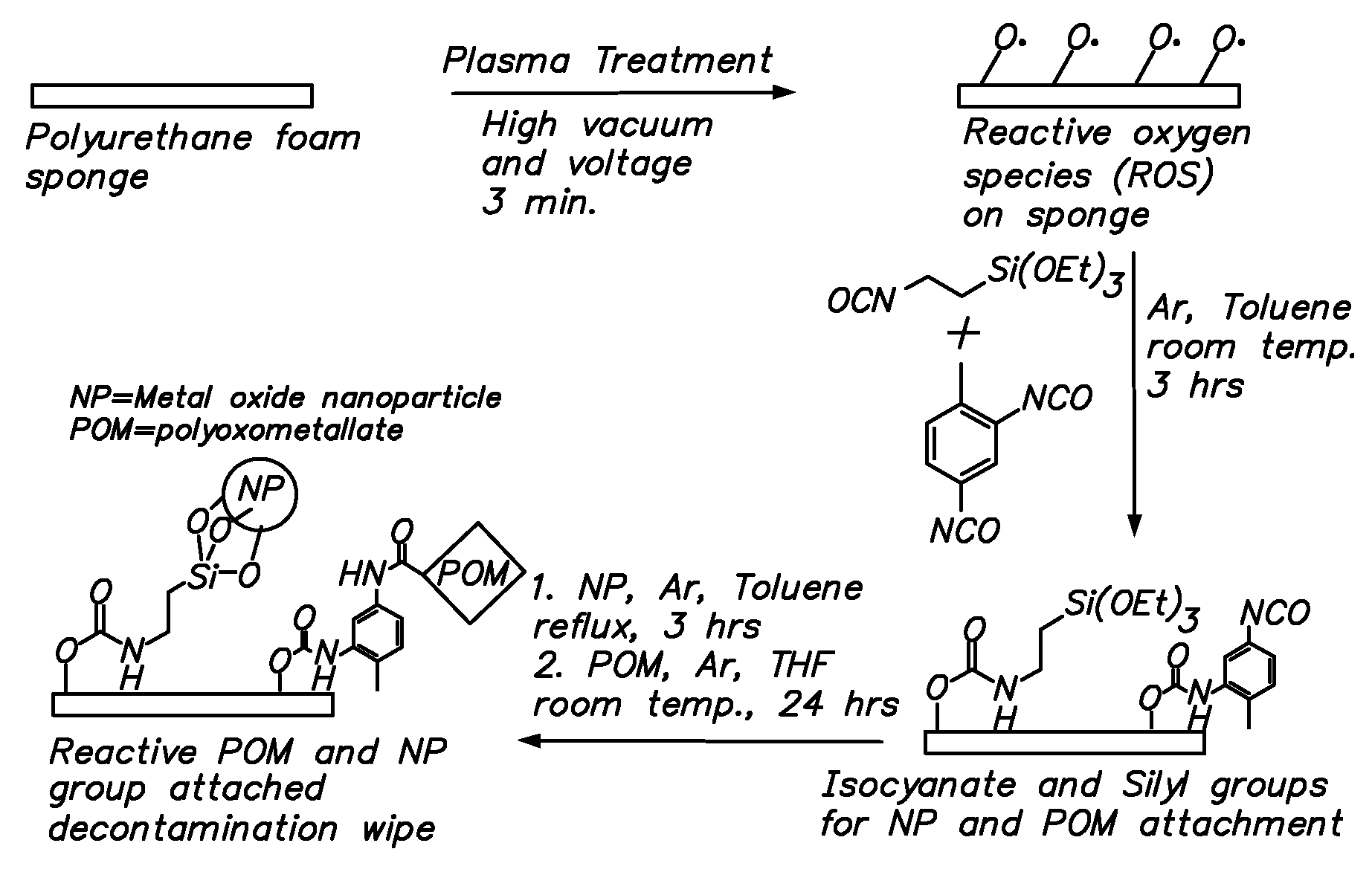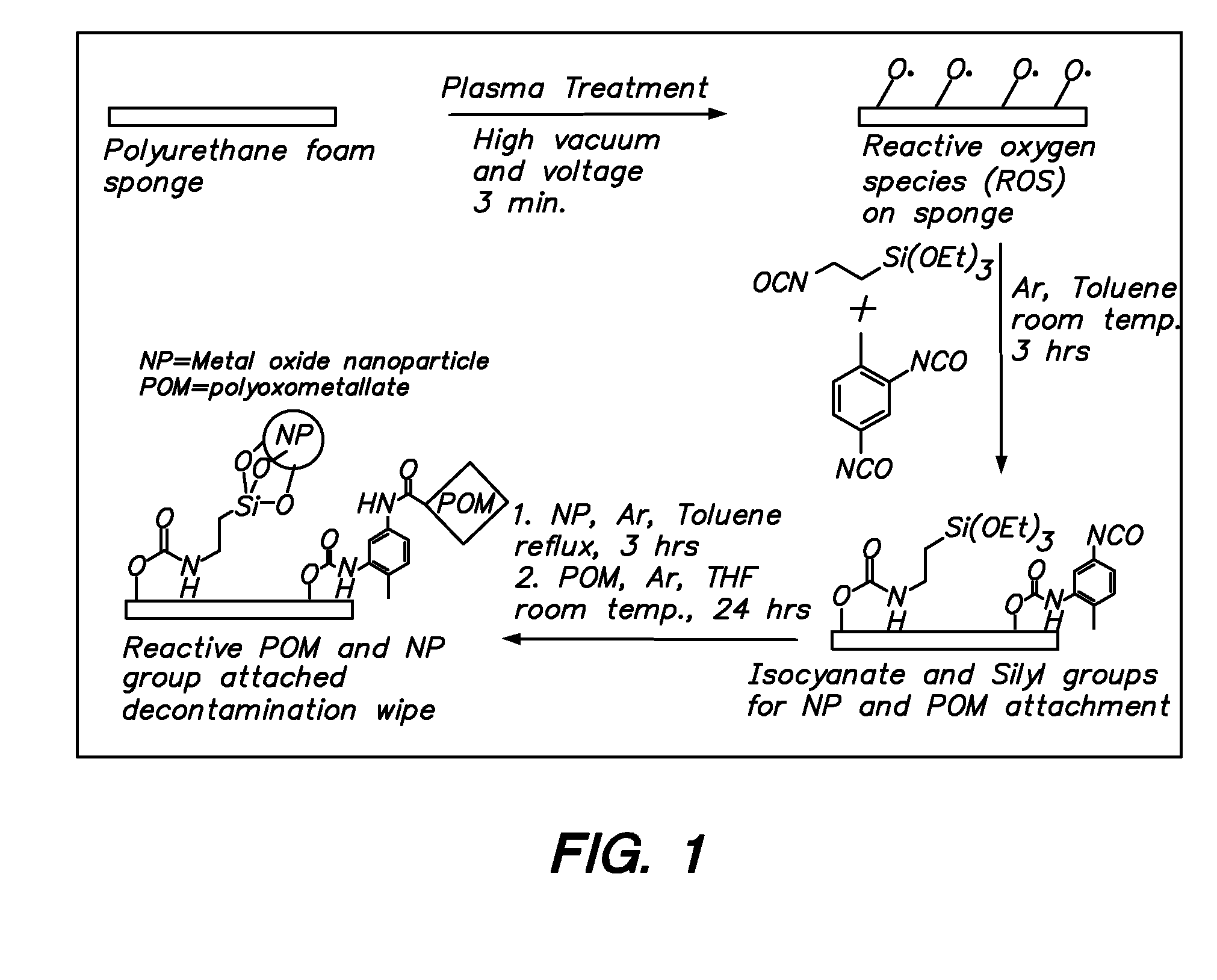Functionalization of polymers with reactive species having bond-stabilized decontamination activity
a technology of reactive species and functionalization, applied in dental prosthetics, impression caps, dentistry, etc., can solve the problems of characterized by intrinsic bulkiness of clothes that are “breathing” and place heavy burdens
- Summary
- Abstract
- Description
- Claims
- Application Information
AI Technical Summary
Benefits of technology
Problems solved by technology
Method used
Image
Examples
example 1
Polyoxometalate Synthesis
[0051]A polyoxometalate complex, H5PV2Mo10O40, was synthesized as follows. V2O5 (1.20 mol) was suspended in 2.0 L water, and the mixture was heated to 60° C. Na2CO3 (1.20 mol) was slowly added, and the solution was heated to reflux for 1 hour. After adding 1 mL 30% H2O2 the solution was maintained at reflux for an additional 1 hour. The solution was filtered, and the filtrate was combined with MoO3 (12.00 mol). The resulting mixture was heated to reflux, and additional Na2CO3 (1.80 mol) and concentrated H3PO4 (1.20 mol) were added sequentially. After 3 hours at reflux, the resulting solution was cooled to room temperature and diluted with water to a total volume of 40 mL, giving 0.3 M H5PV2Mo10O40.
[0052]A second polyoxometalate complex, the silver salt of polyoxovanadomolybdate Ag5PV2Mo10O40, was also synthesized as follows. Silver nitrate (48 mmol) was added to 40 mL of 0.3 M aqueous H5PV2Mo10O40 at room temperature. The resulting precipitate was filtered, ...
example 2
Polyoxometalate Grafting with Tolylene Diisocyanate
[0054]Three 1½ in2 fabric swatches were immersed in 50 mL of a 10 wt % solution of 2,4-tolylene-diisocyante in dry N,N-dimethylacetamide (DMAc) in a 250 mL round bottom flask. 50 μL of dibutyltin dilaurate were added, and the contents of the flask were stirred at ambient temperature for 4 hours. The swatches were then removed and thoroughly washed with DMAc, diethyl ether, and acetonitrile. The swatches were then stirred at ambient temperature for 8 hours with 50 mL of a 3 wt % solution of polyoxometalate (e.g. phosphomolybdic acid) in acetonitrile. The swatches were then removed, padded dry, and washed with water until no more polyoxometalate could be detected in the washes (typically 4 washes). The swatches were finally dried in ambient air.
example 3
Silverization of Polyoxometalate-Grafted Fabric
[0055]A silver treatment was carried out on the material prepared according to Example 2, as follows. The polyoxometalate-functionalized fabrics were added to a 30 mL aqueous silver nitrate solution (1 wt %), washed with deionized water and finally dried under vacuum.
PUM
| Property | Measurement | Unit |
|---|---|---|
| particle size | aaaaa | aaaaa |
| particle size | aaaaa | aaaaa |
| particle sizes | aaaaa | aaaaa |
Abstract
Description
Claims
Application Information
 Login to View More
Login to View More - R&D
- Intellectual Property
- Life Sciences
- Materials
- Tech Scout
- Unparalleled Data Quality
- Higher Quality Content
- 60% Fewer Hallucinations
Browse by: Latest US Patents, China's latest patents, Technical Efficacy Thesaurus, Application Domain, Technology Topic, Popular Technical Reports.
© 2025 PatSnap. All rights reserved.Legal|Privacy policy|Modern Slavery Act Transparency Statement|Sitemap|About US| Contact US: help@patsnap.com



